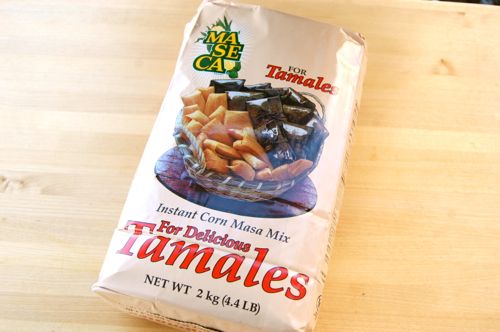Do I make my own scratch masa?
Heck no. I may render my own lard, but when it comes to making masa, I leave that to others. Back home in Chicago I was spoiled. I lived among hundreds of thousands of Mexicans, which meant fresh-made masa was readily available in grocery stores (the ones that catered to the Mexican population, anyway). Louisville doesn’t have nearly enough Mexicans to warrant a tortilla bakery (not yet, anyway), and that’s where fresh masa comes from. Until one of those is put up (hm…possible new business venture?) I make do with the dehydrated stuff.

Instant masa by Maseca is really quite good. The tamales it makes aren’t comparable to the light-as-a-feather ones you get with fresh-ground masa, but they’re still excellent.
Could I make my own masa at home if I really wanted to? Yes, and you can find instructions here. However you’ll need not only a metate but a supply of dried dent corn. “Dent” corn is so-named because the corn kernels have little dimples in the top. It’s extremely common in fields in this part of the country, but because it’s mostly used for animal feed, you tend not to see it in food stores. I wonder where the non-farmer might find some, other than perhaps in a pet supply store, since a lot of people feed it to birds in the winter. I dunno, I’ll have to investigate that. ‘Cause you never know when the desire for fresh masa might strike…
Thanks for the link! I cannot get fresh masa where I live either and have thought about making my own. I’ll probably still just think about it, but it’s nice to know I could if I wanted to. I recently made 2 batches of tamales for a Daring Cooks’ challenge: chicken/tomatillo/serrano in corn husks and pork/guajillo in banana leaves.
Whew those sound good. Send me one? 😉
– Joe
According to Google, there’s one here: http://laguanajuatoky.com/directions.html
Of course, I don’t know anything about the geography of the area and whether that’s a ridiculous trek for you just for some tortillas, but my main point is— us Mexicans are EVERYWHERE.
Well shut my mouth!
I’ll have to get out there and see what they have for sale. There are lots of Mexicans out east of here, more than in the city, so it would make sense that there’d be a bakery there (by far the best Mexican restaurants are around the Shelbyville area). I think a lot of folks work on the horse farms out there. Thanks so much, Mary Sue!
– Joe
Dear Joe,
Congratulations for the great explanation of the history of every ingredient of tamales recipe, I enjoy reading all the posts.
As you write, is very common find- for example here in Mexico -the corn flour to make the dough, in two versions, dry and prepared ready to use ( with lard, baking powder, etc.). The store is named molino de chiles ( pepper grinder store), is located close or inside markets. You can find maseca too at supermarket but is the least option.
If you are a purist, you can make the dough from scratch, but using a home grinder (metallic) not a metate (stone), a metate is for handmade tortillas or chili paste with hard work!- you get a different dough, in a metate you need to add water, so te dough is malleable, in a grinder you don’t put more water, only the soaked corn, the result is a mass not so finely ground which is passed through a strainer for better results.
In many recipes in Mexico, you can see an ingredient: tequesquite. Saltpeper or efflorescent salt, is a mineral salt used instead of salt, as a condiment, but it add more flavor, and can be used as a yeast too, you can find it in form of little stones or powder. You can put the stone in a cup of water and boiled with green tomato skins, once the stone has been dissolved and the water has boiled, it is retired and allowed to settle. The incorporation of tequesquite solution to any dough help it to be fluffed up. If you use tequesquite as an ingredient, you neeed to add less salt and no baking powder. Maybe in mexican markets you can find it, is not neccesary, but interesting.
Best regards
Sandra
That’s very good to know, Sandra. I didn’t realize that a grinder is the preferable tool for this job.
I’ve also heard of that technique with the boiled green tomato (tomatillo) skins, but have never tried it. Someday I will. Thank you for your expertise and interest!
– Joe
Hey Joe – your tamal dough recipe looks great. As for the recipe provided on the Maseca package —in my opinion, forget it! The dough in that recipe is much too slack and very difficult to work with. I’ve been meaning to re-work the Maseca recipe, but haven’t done it yet. Thanks for doing the work for me!
It was really Rick Bayless…but I’ll take the credit if you’d like! 😉
– Joe